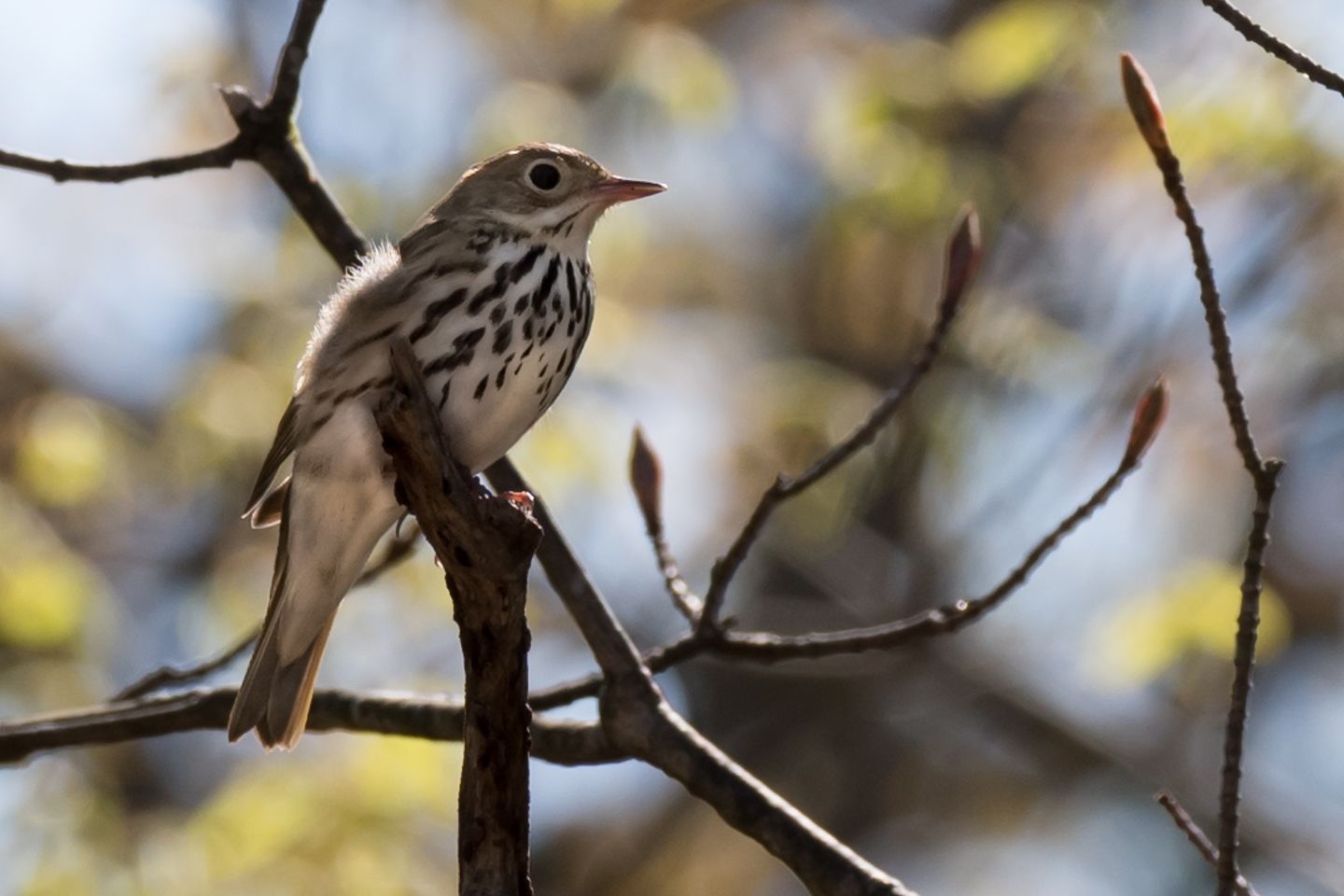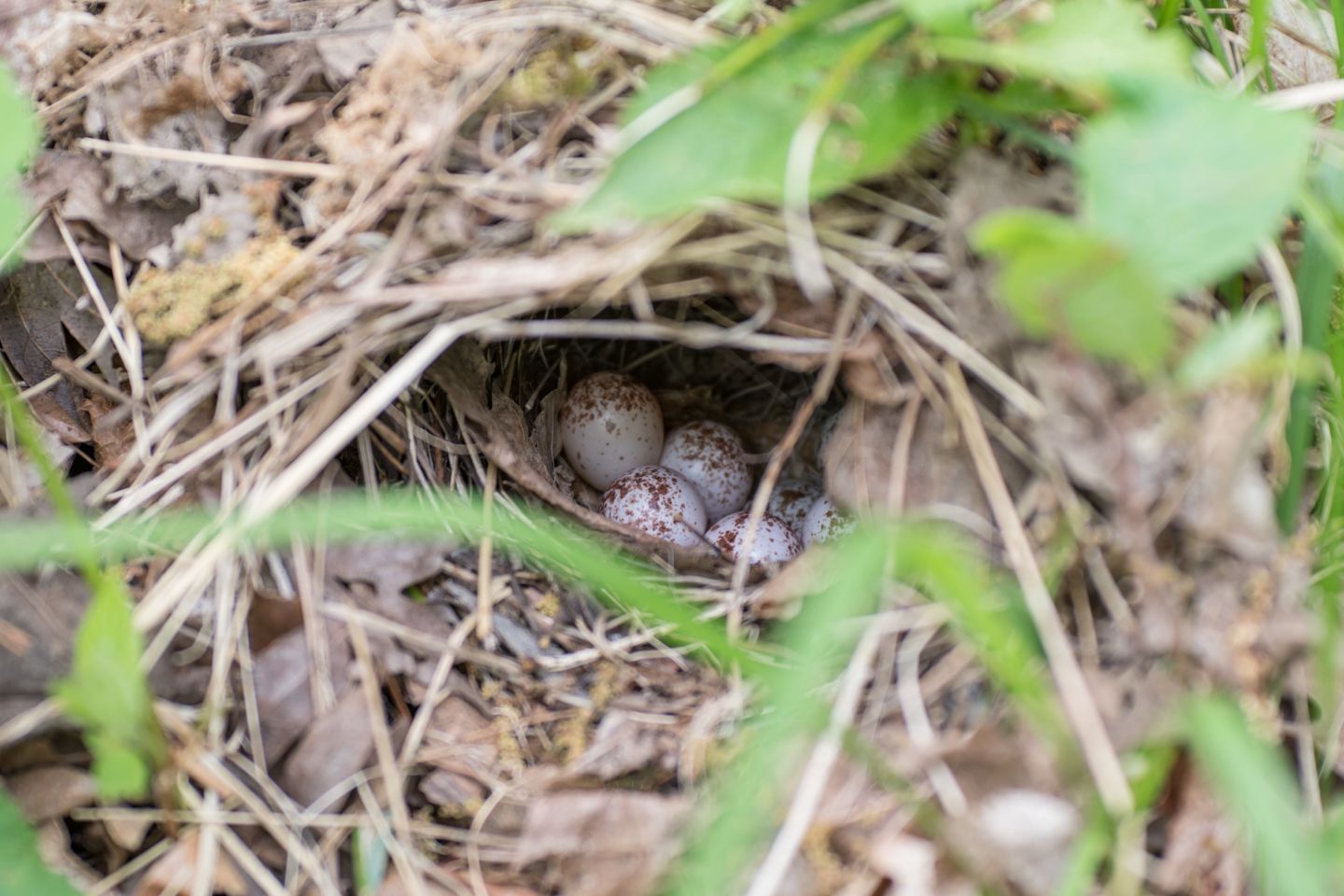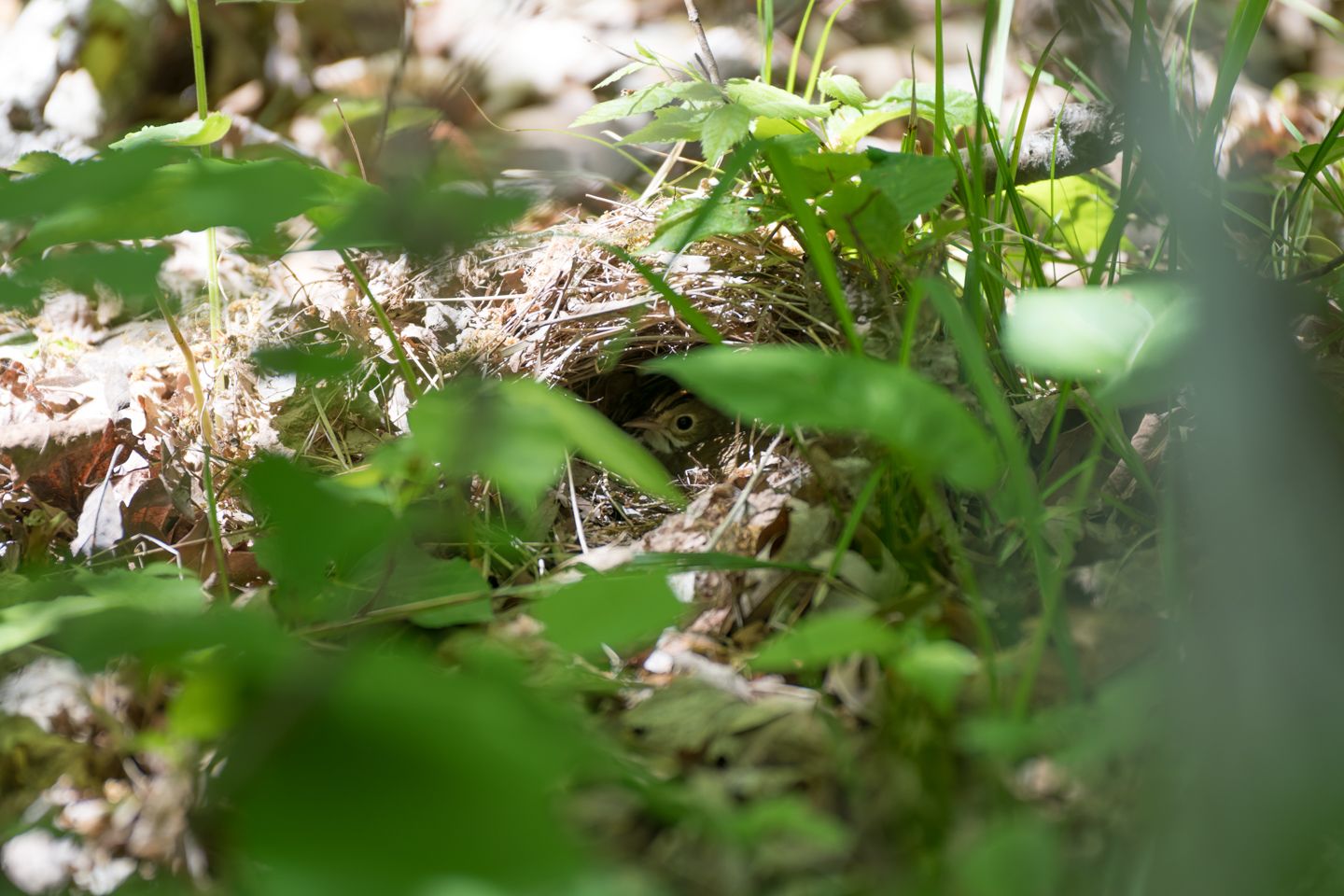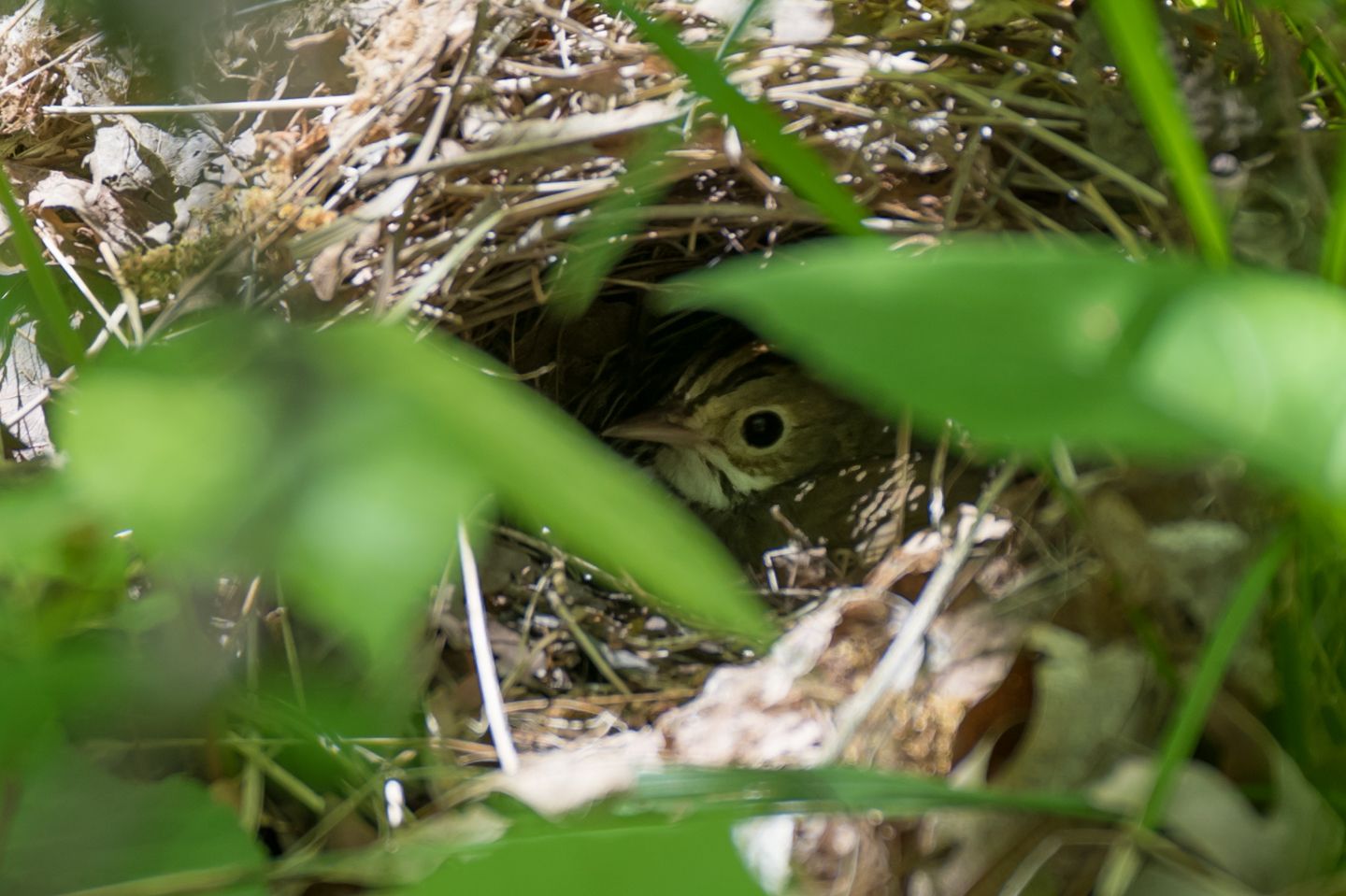One of the most familiar warbler songs, as well as one of the easiest to learn, is the loud, ringing song of the Ovenbird. Well described as “Teacher, Teacher, Teacher,” in the north or “Teach, Teach, Teach,” in the southern part of the breeding range, it is highly distinctive. Identification of this large but cryptic plumaged warbler is far easier by sound than sight. As a bird of large woodland interiors, this species is still fairly common over much of its North American breeding range. Heavy forest fragmentation has impacted some populations, but extensive woodlands, including the Tug Hill Plateau, harbor them in abundance.

In Northern New York, their striking song is heard least often in the small wood lots surrounded by intensive agriculture. Along the St Lawrence, they become more frequent in more extensive woods within the core of the Algonquin to Adirondacks (A2A) corridor. This pattern is similar on the Canadian side with few breeders on Wolfe Island but more occur on large wooded islands farther east. They are absent as breeders on small islands but are regular inhabitants of sites such as the preserved songbird forest near the foot of Grindstone Island. Large woodlands equal breeding Ovenbird presence.
This species is a migrant, primarily wintering from southern Mexico, to the extreme north of Venezuela, and on the islands of the Caribbean. Unlike most Neotropical migrants, substantial numbers of Ovenbirds winter in the southern 2/3 of the Florida peninsula. The breeding range extends from the mountains of Georgia to Newfoundland and west to the forested areas of the prairie provinces. They are absent from areas that lack adequate forests. They are a frequent migrant over much of the continent east of the Rockies. Arriving at northern latitudes by May, most depart our eastern forests by late September to early October.
While most migrants to the New World Tropics have suffered significant population declines in the last half century, this species is still doing reasonably well. I have a five mile roadside census route near my home on Tug Hill where 50 singing males can be found, thus one every tenth of a mile. While generally less frequent in most lower altitude forests, Ovenbirds are still fairly common in the larger woodlands found on Thousand Islands Land Trust preserve near Crooked Creek and similar lands elsewhere, For the foreseeable future, it is highly likely that the ringing breeding song of this species will be heard locally for years to come.

One of our largest wood warblers, this species is also one of the best studied. Relatively common and easy to locate, they have been the subject of numerous studies. As a ground nester, their reproductive success can be monitored without risking body parts climbing into the canopy of tall trees. Being highly territorial and very loud, their breeding biology is relatively easily studied. As with most long-distance migrants, we know far less about other critical life cycle stages. Most studies of wintering and stopover ecology are relatively recent and limited but some progress is being made.
In our part of the world, Ovenbirds largely feed on Arthropoda gleaned from under leaf litter. Within their preferred forest habitat, there are areas of micro habitats with some preferred over others. Areas with less ground cover and a thick layer of leaf litter seem to provide the basics for an excellent territory. Many of our eastern forests are over browsed by excessive white-tailed deer populations that impact the shrub layer. Perversely, this imbalance of nature that damages forests, could in the short run, favor Ovenbird populations. Deer overpopulation is a result of human causes but some species are harmed while others benefit.

This species derives its common name from its domed nest that resembles an old fashioned Dutch oven. As a ground nester, they are subjected to much higher rates of nest predation than species nesting in shrubs or trees. Their overall dull colors allow the female to blend in well with her environment as she remains motionless while sitting on eggs. This can be clearly seen from Julie Covey’s photo taken of a nest located along a heavily used trail. Evolution had provided these birds with cryptic coloration and they have great faith in its effectiveness.
As with most Neotropical long distance migrant songbirds, there is little time to waste and the breeding season gets underway quickly. About a week after arrival the female initiates nest construction. When it’s complete, she usually starts laying four eggs and begins incubation, a process requiring about two weeks. The male is not involved in family activities until the young hatch, and both parents feed the young. In another two weeks ,the young fledge, and many broods are divided between adults, thereby reducing likelihood of loss of entire brood to predation. Only one brood is generally raised annually at our latitude, although two broods in one year have been reported in more southern climes.
As the young grow and develop strength for the long migration to come, the males’ song gradually decreases. By early August, song is infrequent but I have heard migrants vocalizing in October. Often the poor quality of these efforts would suggest young males just practicing for things to come, should they survive the winter. During the late summer, Ovenbirds join the mixed flocks of other migrants to the tropics, as well as other small birds, in drifting through the forest feeding for journeys to come.

These forests in late summer are now silent and song free with distinctive vocalizations replaced by obscure chirps, tweets, and other contact notes. Many of the Ovenbirds’ companions on these local travels are nearly as or more cryptically colored than they are. These flocks of “confusing fall warblers” and friends offer a real challenge to the observer. The best ways to enjoy and learn these birds are to sit quietly and study them when a flock is found. One of the best ways to find these flocks is to listen for the chatter of Black-capped Chickadees that are often accompanying these groups.
At some point, feeding flocks turn into true migration. For Ovenbirds at our latitude, that probably begins in mid-August and peaks in mid- to late September. Few linger after the first third of October and individuals present beyond late October are probably injured or ill and will be sorted out of the gene pool. As these largely silent unobtrusive migrants slip south it’s hard to imagine that survivors who return next spring will fill the forest with loud boisterous song. While River Rats headed to South Florida may see quiet skulking wintering Ovenbirds, those remaining in a northern winter can only anticipate things to come.
By Sherri Leigh Smith, goshawk@gisco.net
Photographs by Julie Covey, Nature in NY (https:www.facebook.com/NatureinNNY/)
Sherri Leigh Smith is the Senior Ornithologist in northern NY. He is passionate about birds and their conservation. Sherri Leigh has written numerous articles for TI Life, and you can see several of them here.
Editor’s Note: This editor is both pleased and appreciative of Sherri Leigh Smith for taking the time to help us understand more about birds and nature in the islands. She and nature photographer Julie Covey, provided wonderful contributions for fall 2020, winter 2021 and spring 2021. Now that we are well into summer we are really enjoying our flying friends. We had a family of robins on our front verandah light - the fourth baby robin left the nest on July 1. Now we have our front door back, but I miss them!
Posted in: Volume 16, Issue 7, July 2021, Nature
Please click here if you are unable to post your comment.
